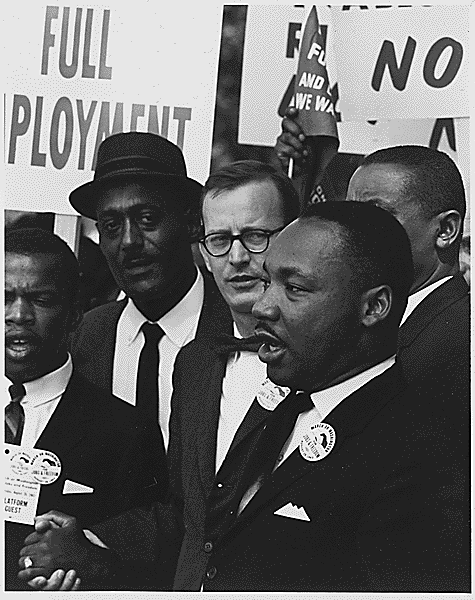José Calderón
Inland Valley Daily Bulletin
Reprinted with permission, originally published on 01/24/2009 05:10:47 PM PST
The commemoration of Martin Luther King Jr. comes at a time when there is a movement developing throughout the country that is calling for change. It is the same kind of movement that gave rise to the civil-rights movement in this country. We know today that it is the movement which makes the leader and that the best leaders espouse the needs and demands of that movement. King was such a leader.
While it is important to bring to center stage the leadership of King, it is equally important to commemorate the thousands of people involved in the Montgomery Bus Boycott between 1955 and 1956, the Greensboro sit-in of 1960, and the marches (such as the Selma-to-Montgomery marches of 1965 in Alabama).
It was the tenacity of the Montgomery Improvement Association to desegregate buses that made King a nationally known figure. Here, it is important to remember the courage of Rosa Parks, a seamstress by profession and a secretary for the Montgomery chapter of the NAACP, who took a stand and refused to move to the back of the bus. It is also important to remember 15-year-old Claudette Colvin who, before Parks, was actually the first African-American woman arrested early in 1955 for refusing to give up her seat.
The actions in Montgomery were an example of a social movement involving a diversity of leadership. For months, the African-American community, with some support from other communities, responded to the arrest of Parks and historical segregation by developing their own system of carpools. Many used cycling and walking as alternatives to riding the bus. Their tenacity led to a Nov. 13, 1956, Supreme Court ruling that Alabama’s racial segregation laws for buses were unconstitutional.
The beauty of this organized movement was that it took on the power structure in Montgomery. It was an example of common working people using their social capital, their economic capital, and their spiritual capital – as tools for building community unity.
It was an example for all of us today – when an increase in ethnic/racial conflict in our diverse communities has more to do with having to compete for diminishing resources.
We share some of the same common structural realities: a deepening economic crisis, a decline in manufacturing, the development of an information/technological society requiring a much more educated work force, and segmentation in the lowest levels of the economy. Many of us, regardless of our social standing, are treated as the “outsiders” of a rapidly changing technological society.
King, today, symbolizes to me the type of leadership that we need today.
It should be pointed out that it was only four decades ago that King helped to unite thousands from all backgrounds in opposing the war in Vietnam. It should be pointed out that, when King was killed, he was helping to lead a strike in Memphis, Tenn., involving hundreds of working people of all colors, ages and genders who were aiming their efforts – not at each other – but at the structural conditions that were affecting their standard of living.
During the strike, King spoke to the workers and reminded them of the dignity of their labor:
“So often we overlook the work and the significance of those who are not in professional jobs, of those who are not in the so-called big jobs. But let me say to you tonight that whenever you are engaged in work that serves humanity and is for the building of humanity, it has dignity and it has worth.”
Although King was killed in Memphis, this movement did not end. Ultimately, this 64-day strike ended with a union contract for sanitation workers and it gave life to public employee union organizing in other parts of the South.
Today, there are many of us who believe that the significance of the election of Barack Obama is not just in the individual but is in the rising of a new social movement that is uniting people from all diverse backgrounds in advancing a change in the way this country is run and whose interests it serves.
The legacy of King is seen everywhere in our schools, churches and communities. It is present in all the common people who are turning an abstract call for “hope” and “change” into organizing efforts of accountability for quality education, health care, employment, education and human rights for all. This is the same legacy of those who refused to sit in the back of the bus in the 1950s. It is a simple social movement to take back our dignity.
Jose Zapata Calderon is a professor of sociology and Chicano studies at Pitzer College in Claremont.



Good blogging!
Wonderful pictures on this website! I read the article on MLK’S Legacy by Jose Calderon and was moved to tears by Mr. Calderon’s inclusion of all the faceless and nameless thousands of people who actually were the backbone of the movement for Civil Rights. His special mention of Rosa Parks’ role as the Secretary of the Montgomery NAACP chapter reminds us that women, indeed hold up half the sky! He even included a little known fact: a teenage girl, Claudette Colvin, was actually the first African American woman to be arrested for sitting at the front of the bus……INSPIRING!! Thanks Luci for setting this up:)
Pingback: Martin Luther King's Dream | Jose Z. Calderon